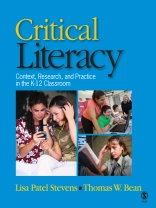‘This is an excellent text. I particularly liked how the authors share examples of critical literacy throughout the book, especially with digital and multimedia texts.’
—Peter Mc Dermott, The Sage Colleges
‘Through realistic discussion of how text shapes us and is shaped by us, Critical Literacy provides pre- and in-service teachers with concrete ways to engage in critical literacy practices with children from elementary through high school.’
—Cheryl A. Kreutter, St. John Fisher College
…a unique, practical critical literacy text with concrete examples and theoretical tools for pre- and in-service teachers
Authors Lisa Patel Stevens and Thomas W. Bean explore the historical and political foundations of critical literacy and present a comprehensive examination of its uses for K-12 classroom practice.
Key Features:
- Focuses on the nexus of critical literacy theory and practice through real classroom examples, vignettes, and conversations among teachers and teacher educators
- Illustrates how critical literacy practices are enacted in the classroom at the elementary, middle, and high school levels.
- Offers step-by-step teaching strategies for implementing critical literacy in K-12 classrooms at different paces, depending on existing curriculum
Intended Audience:
This is an excellent supplemental text for a variety of advanced undergraduate and graduate courses in education departments on how to teach reading and writing. This text will also appeal to instructors and students exploring issues of representation, linguistics, and critical deconstruction.
विषयसूची
Foreword by Michele Knobel
Preface
Chapter 1: Redefining Literacy
Genealogy of the Critical: Paulo Freire
Defining Critical Literacy
Mrs. Cutter’s Class
Problematizing Classroom Applications of Critical Literacy
Chapter 2: Why We Need Critical Literacy: Dynamic Texts and Identity Formation
Literacy Proficiency and New Texts: A Moving Target
Texts, Attention, and Identity?
The Transformation of Texts and Readers’ Attention
Texts as Tools of Identity Formation
Texts: Mediating Identity and Culture
Chapter 3: Critical Literacy and Teacher Education
Teacher Identity
Risk, the Future, and Critical Literacy
Disrupting Education Discourses With Critical Literacy
Critical Media Literacy and Teacher Education
Resident Critic
Chapter 4: Critical Literacy at the Nexus of Praxis
Maintaining Critical Literacy as a Moving Target
Essential Features of Critical Literacy
Chapter 5: Praxis Point 1: Popular Culture, Fandom, and Boundaries
Snapshot 1: Critical Media Literacy and Social Studies
Reflection: Practice Informing Theory
Chapter 6: Praxis Point 2: Critical Numeracy Across the Curriculum
Snapshot 2: Critical Literacy Across the Curriculum
Reflection: Practice Informing Theory
Critical Literacy and the Institutional Context
Chapter 7: Praxis Point 3: Cycles of Deconstruction and Reconstruction
Setting the Context and Participants
Reflection: Practice Informing Theory
Assessing Critical Literacy
Reflections on Critical Literacy as Praxis
Chapter 8: Critical Literacy and Educational Policy Texts
What Is Policy?
Critical Policy Analysis
National Discourses
Moving From National to Local: Complex Connections
Chapter 9: Critical Policy Analysis in Local Contexts
Policy and Governmentality
Local Conversations
Transforming Policy Interactions
Educational Policy and Complexity Theory
लेखक के बारे में
Thomas W. Bean, Ph.D., is a Professor of Literacy and Reading in the Teaching and Learning Department, College of Education, at the University of Nevada, Las Vegas. Tom earned his Ph.D. at Arizona State University and is considered a leading scholar in content area literacy and the infusion of multicultural and global young adult literature in the classroom. His work has been published in the ALAN Review, Reading Research Quarterly, and the Journal of Adolescent & Adult Literacy. Along with Co-Author Dr. Judith Dunkerly-Bean, he served as co-editor of the International Reading Association’s Journal of Adolescent & Adult Literacy. Tom is senior author of the widely used text, Content Area Literacy: An Integrated Approach (10th ed.). He can be contacted at: [email protected].












